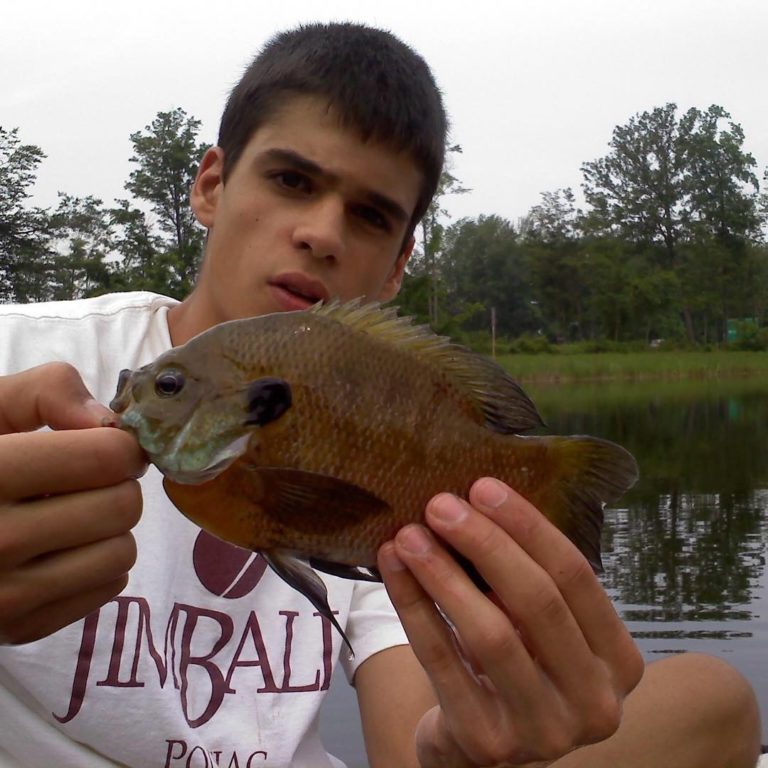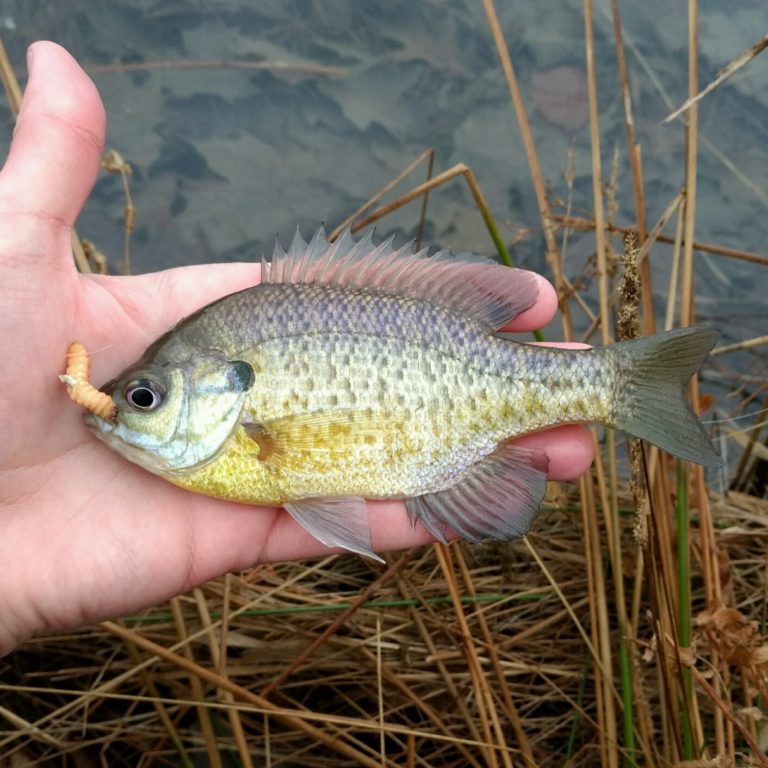The Bluegill

The bluegill (Lepomis macrochirus) is a warm-water “panfish” found throughout western New York. Bluegill typically range between 5 and 9 inches in length and can be identified by their broad, purplish-greenish-gold body, spiny dorsal fin, orange-gold breast area below the gill plate and pectoral fin, and characteristic black tab on their gill plate.
Bluegill somewhat resemble their close cousin, the pumpkinseed. There are a few differences that distinguish bluegill from pumpkinseeds. One difference is coloration. Bluegill are typically more uniform and dull in color, while pumpkinseeds usually have darker green splotches that starkly contrast underlying hues of light green or teal. Also, the black tab on a pumpkinseed’s gill plate has a bright red spot on it, while the tab on a bluegill’s gill plate is uniformly black. Bluegill and pumpkinseed are probably the most abundant fish in western New York.
Habitat
Bluegill are warm-water fish and are extremely temperature tolerant. Bluegill can tolerate temperatures well in excess of 70 °F in the summer. Given their adaptability, bluegill can be found in any body of water: streams, creeks, rivers, ponds, and lakes. The only place where bluegill might be hard to come by is cold, clean, well-oxygenated wild trout streams.
In ponds and lakes, bluegill roam the weedy areas close to shore. In May, bluegill can be seen building nests that look like craters in the shallow sections of lakes and ponds. Bluegill usually only leave the shallows when the weather gets cold, when they move to deeper parts of ponds and lakes. In creeks and rivers, bluegill can be found in slow moving sections, especially where cover is present.
Food
A bluegill’s diet consists primarily of insects. Bluegill eat aquatic insect larvae, aquatic insects, or really any insect that lands on the surface of the water including bees. In fact, bluegill can be so indiscriminant in feeding that pieces of grass, tree bark, or flower petals thrown onto the water can often trigger a bluegill to strike. Large bluegill will sometimes eat small minnows and can sometimes be caught on small stick baits.
Where to Catch Bluegill
Bluegill can be found pretty much everywhere and are abundant in all counties of western New York. Bluegill are usually stocked in ponds and lakes in neighborhoods and public parks. Ponds and lakes that aren’t stocked almost always have a self-sustaining population of naturally reproducing bluegill. Local ponds are probably the best place to target bluegill, where they can be seen cruising the shallows, often in large numbers. For this reason, bluegill and pumpkinseed are probably the best fish to target when taking children fishing. Bluegill and pumpkinseed are always eager to bite, and sight fishing keeps both kids and adults interested.
Late spring through fall is the best time to target bluegill. During the early months of spring, when ice is unsafe or gone and water is still cold, bluegill can be lethargic and tough to catch. During May into early June, bluegill will occupy the shallows of ponds and lakes making nests and spawning. During the spawn, bluegill do not focus heavily on feeding. Usually starting in June, bluegill begin to feed and become quite easy to catch. From June through October, bluegill occupy shallow, weedy areas of ponds and lakes in large numbers and can be sight fished from shore.

How to Catch Bluegill
Bluegill can be caught on pretty much any reasonably sized bait, artificial or live. However, there is no need to complicate things. The classic worm and bobber is the best way to go when trying to catch bluegill. A small hook with a piece of nightcrawler fished a half foot to a foot under a bobber is almost guaranteed to produce fish. A small split shot weight can be added several inches above the hook if needed.
When fishing for bluegill, it is most productive to sight fish. Bluegill usually hang out close to shore, so if you can’t see any where you’re casting, they probably aren’t there. Walk along the shore until you find some fish, and cast away. When casting, try to cast past the fish then slowly reel your bait toward them. Casting on top of fish can scare them. However, bluegill probably won’t scare much if they’re getting nightcrawlers thrown at them. It is not uncommon to catch the same bluegill several times in a row.
